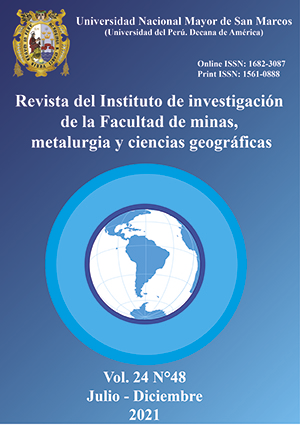Geometallurgical model of the characterization of clays for flotation efficiency using machine learning methodology
DOI:
https://doi.org/10.15381/iigeo.v24i48.21706Keywords:
Mineralogy, x-ray diffraction, near infrared spectroscopy, chemometrics, machine learning, cross validation, froth flotationAbstract
The geometallurgical model is the result of the integration of the disciplines of geology, mining and metallurgy in order to add value and reduce risk in a process such as the flotation efficiency of chalcopyrite. The objective of this study was to calibrate models to quantify the content of clays and gangas of a hydrothermal deposit of the porphyry copper-gold type by NIR spectroscopy. The selected methodology was to design a chemometric model based on 173 diamond drill composites to which X-ray diffraction tests and near infrared spectroscopy were performed, validating the results with a cross-validation through a machine learning methodology. The creation of the models was carried out by means of a regularized non-linear regression by the Ridge method. Low linearity models were obtained for calcite and plagioclase minerals, with R2 values (0.51 and 0.78, respectively). The regression model presents a linearity for smectite, quartz, orthoclase and muscovite minerals showed a high R2 (0.95, 0.93, 0.64 and 0.59, respectively). The results found for the content of clays and gangue indicate that X-ray diffraction analyzes can be largely replaced by spectral models. In the case of calcite and plagioclase, it would be convenient to carry out a characterization campaign, in order to improve the model and to be able to replace the x-ray diffraction analyzes for these species, which will allow to generate a geometallurgical model in a quick and easy way. efficient with a semi-quantitative method.
Downloads
Published
Issue
Section
License
Copyright (c) 2021 Julio Alejandro Castro Andrade, Julia Marilú Calderón Celis

This work is licensed under a Creative Commons Attribution 4.0 International License.
AUTHORS RETAIN THEIR RIGHTS:
a. Authors retain their trade mark rights and patent, and also on any process or procedure described in the article.
b. Authors retain their right to share, copy, distribute, perform and publicly communicate their article (eg, to place their article in an institutional repository or publish it in a book), with an acknowledgment of its initial publication in the Rev. Inst. investig. Fac. minas metal cienc. geogr.
c. Authors retain theirs right to make a subsequent publication of their work, to use the article or any part thereof (eg a compilation of his papers, lecture notes, thesis, or a book), always indicating the source of publication (the originator of the work, journal, volume, number and date).























